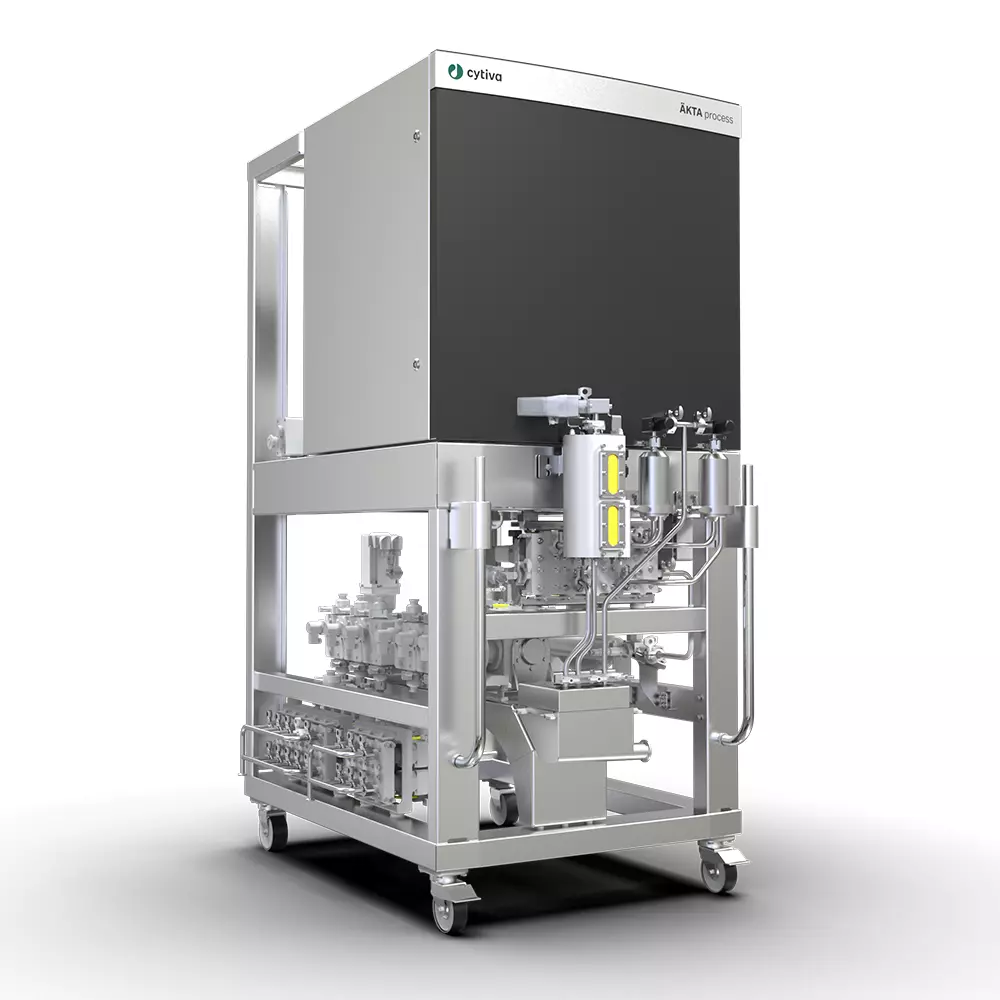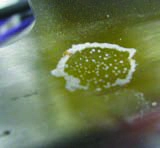We determined the compatibility of legacy ÄKTAprocess™ and the next-generation ÄKTA process™ chromatography systems with common cleaning processes for external surfaces, including fogging of the entire system using a commercial fogging solution. Note that the study does not detail any microbiological decontamination advantages or disadvantages in any of the methods used.
Introduction
Large-scale chromatography systems for bioprocessing are exposed to a variety of cleaning agents as well as several potentially aggressive chemicals (e.g., salts, aldehydes). We designed this study to test the compatibility of ÄKTAprocess™ systems (Fig 1) with several common cleaning agents. The systems and components were exposed to common surface cleaning agents and were also tested for response to clean room fogging agents. Tests were designed to assess local (spot) cleaning effectiveness as well as a whole-system method using a common fogging method.
This article is based on the application note “Cleaning procedures for ÄKTAprocess system external surfaces” (CY13216), which was originally published in 2009 using the legacy ÄKTAprocess system. Materials used on the next-generation ÄKTA process™ CFG chromatography system are equal to or improved regarding chemical compatibility compared to the legacy ÄKTAprocess™ system. Therefore, chemical resistance and procedures used in this study should also apply to the next-generation ÄKTA process™ CGF system. All mentions below for ÄKTAprocess™ refer to experiments performed on the legacy ÄKTAprocess™ system.
Fig 1. ÄKTA process™ CFG next-generation chromatography system (left) and the legacy ÄKTAprocess™ system (right).
Click here for details of materials and methods used in this study.
Results and discussion
Component test
Surface tests
Most component surfaces tested showed no detectable effects (grade 5 according to Table 1) of any of the cleaning solutions or the salt residues.
In experiment 1—Common cleaning agents were used, exceptions included: (1) the power supply connection (blue polycarbonate) showed noticeable surface marking when viewed at certain angles; (2) The blue surface color of the Roxtec cable (polymer) bled slightly when exposed to cleaning agents; and (3) the steel surface of the flow meter showed slight bleaching.
In experiment 2—Salt residues were used, exceptions included: (1) the steel surface of the flow meter showed rust spots after exposure to NaCl (but prior to wiping) and slight bleaching when exposed to isopropanol and ethanol; and (2) some EPDM membranes showed slight discoloration when exposed to NaOH.
Fogging test
The results showed that most of the component parts showed no surface impact after short- or long-term exposure to NaOH and NaCl. Sodium chloride, however, caused rust stains where salt residues were present on some areas of exposed steel, and this effect was amplified in combination with fogging, showing black spots after wiping. We therefore recommend that steel parts are cleaned of any residues using water prior to clean room fogging treatments with Minncare solution. Following fogging, functional tests of the system circuit card as well as the CU-960 control box were all successful.
System testing
Surface test
None of the tested surfaces were affected by the cleaning chemicals 3% Minncare solution and 6% hydrogen peroxide.
Fogging tests
We found that fogging of an entire ÄKTAprocess™ system gave results similar to the component fogging study—Minncare disinfectant solution in combination with salt residues tended to exacerbate the rust effect on stainless steel surfaces (Fig 2).
Fig 2. Examples of incipient rust on areas of salt residue on steel surfaces after fogging.
Fig 3. Areas of salt residue and subsequent rust (left photo) are normally easily removed with gentle cleaning with water (right photo).
In most cases, we could remove residue and rust with gentle wiping of the surface using water (Fig 3). No effects were seen on tags, adhesives, or labels. The results suggest that cleaning of external surfaces (with special attention to steel surfaces) is important before fogging of ÄKTAprocess™ systems. Although the fog slightly penetrated the electrical system cabinet, no effects of the fogging were seen on system functional performance.
Conclusions and recommendations
Our study results show that common cleaning agents such as 70% ethanol and 70% isopropanol can be used on the legacy ÄKTAprocess™ and the next-generation ÄKTA process™ system. The only case for concern is when steel is in contact with salt residues. In such cases, you should take care to completely remove salt residues prior to cleaning (step 1 below).
We suggest the following recommendations for cleaning your legacy ÄKTAprocess™ or next-generation ÄKTA process™ system:
- Regularly wipe/wash off system surfaces with water to remove salt and other external deposits. Note that this step is mandatory prior to performing either of the following procedures!
- Regularly clean system surfaces with 70% ethanol or 70% isopropanol, and before placing the system in a clean room environment (according to SOPs).
- Clean room cleaning techniques may include fogging with Minncare solution (22% hydrogen peroxide, 4% peracetic acid) according to SOPs.
Find out more about our next-generation ÄKTA process™ chromatography systems.
Click here to read more related contentCY13216-18Sep23-AN
Customer surveys were used to ascertain the most common cleaning agents used in association with chromatography systems and associated clean rooms. The cleaning agents most often used are ethanol, isopropanol, hydrogen peroxide, and peracetic acid in various concentrations and mixtures. While these solutions provide well-documented cleaning effects, they can sometimes also react with surface finishes to cause discoloration. To test the effects of cleaning agents on ÄKTAprocess™ system, we used two approaches, one involving individual system components, and the other involving entire systems. In both cases, surface cleaning and fogging were the methods used.
Component testing
Surface tests
In the manual application tests, a wide variety of component surfaces were tested including most areas that are subjected to exposure of commonly applied chemical solutions such as salts, buffers, and caustic agents. All surfaces/components were photographed prior to testing, and again following testing if the effects of cleaning agents were evident. In addition, duplicate components were also left untreated for comparison with treated surfaces.
A grading system was used to qualitatively assess the results of the cleaning results. The grading is summarized in Table 1.
Table 1. Grading system used to evaluate results
Grade assigned Observed results
0 Surface has dissolved and is fully or partially visible.
1 Surface has dissolved and comes loose when touched.
2 Surface has dissolved but is otherwise intact.
3 Change in surface color. Stains visible from all directions when the surface is angled towards a light source.
4 Change in surface color. Stains disappear at certain angles when the surface is angled towards a light source.
5 No effect observed.
Experiment 1—common cleaning agents
A cotton swab was used to wipe the common cleaning solutions 6% hydrogen peroxide, 70% ethanol, or 70% isopropanol on the material surfaces for 5 s, the solution was allowed to evaporate, and this wiping procedure was then repeated for a total of 10 applications. Surfaces were marked to show which cleaning agent was applied.
Experiment 2—salt residues from buffer
In normal applications, salt residues from buffers are commonly found on system surfaces. In this experiment, component surfaces were treated with 2 M NaCl and 1 M NaOH, which were applied until the residue was visible. The resulting residue areas were marked and left to dry for either 24 h (NaCl) or 72 h (NaOH). Following these incubation periods, the residue areas were gently wiped with 70% isopropanol or 70% ethanol to clean away the salt residue.
Fogging test
We exposed ÄKTAprocess™ system components to salt residues and dry fog (spraying of a fog of small droplets of the cleaning solution over surfaces, Fig 4) to determine any detrimental effects of fogging on material integrity. We created salt residues by dripping small amounts of 1 M NaCl and 1 M NaOH onto component surfaces until residues were established.
We used two residue contact times—a short-term contact of less than 3 wk—and a long-term contact of greater than 1 month (mo). The electronic components were also exposed to the outside of the normal cabinet environment and tested for function.
Many of the component surfaces were tested, covering most of the exposed surfaces of an ÄKTAprocess™ system.
Fig 4. A nozzle applying fogging solution.
Fogging of system components was carried out with a Dry Fog disinfectant system (Fig 4) dispensing Minncare solution (22% hydrogen peroxide, 4% peracetic acid) according to supplier recommendations (contact time = 1 h).
Environmental conditions during fogging were:
Relative humidity: 70% to 90%
Temperature: Room temperature (approx. 20°C)
System testing
Surface test
Surface tests for systems were carried out by wiping surfaces by hand, 10 times, with 3% Minncare solution or 6% hydrogen peroxide. Focus was kept on materials, such as polymers and on equipment tags, that were thought to be potentially sensitive to cleaning agents.
Fogging tests
Large-scale fogging tests on two ÄKTAprocess™ systems were carried out in a limited space using Mini Dry Fog disinfectant system dispensing Minncare disinfectant solution (as in the component tests described in the previous section). Systems were shut off prior to the fogging tests.
For the fogging tests, selected surfaces on an ÄKTAprocess™ system were exposed to 2 M NaCl and 1 M NaOH for a period of about 1 wk. Fogging was then performed five times to simulate a heavy fogging scenario. As a control, another ÄKTAprocess™ system—which was not exposed to salt residues—underwent a single fogging treatment.
The fogging system was set in a 15 m3 room but carried out in a 9 m3 space to simulate a worst-case scenario with respect to fog concentration. We used the same general testing conditions for the fogged system that was not exposed to salts.
We visually inspected all surfaces and recorded the results. After the five fogging treatments, we performed a system functional test to verify that the fog testing did not affect the performance of the system.






